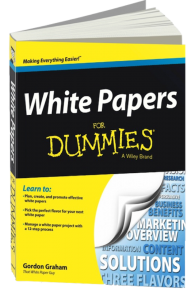So, a few weeks back, I get an email from one of my favorite graphic-design partners*, asking for a favor. This is how we roll, by the way. We trade out services: she designs my book related business cards, flyers, and even some of my sites, and I do copy for her sites and promo materials. It’s worked out wonderfully.
Anyway, she was putting together a proposal to a prospect, and wanted me to tailor a cover letter I’d written for her some years back to accompany an earlier proposal. The letter outlined her capabilities, strengths and background, and how all of that translated to benefits to the client.
She sends the letter, I read it, and I’m shocked (shocked, I say). Seriously, I’m asking myself (out loud, if memory serves), “Did I really write this?†Apparently so.
Because, wow. It was wordy, verbose (see, there I go again!), uber-flowery, etc. All this grandiose copy that was, frankly, far more than necessary for this proposal, the earlier proposal—heck, any proposal.
So, I took out my razor-sharp, double-edged editing pen, and went to work. When I was done, it was probably half its original length, far more succinct (by definition, I suppose), but still covered the same ground. Whew.
So, it got me thinking. Clearly my writing skills had evolved in the past 3-4 years, and for the better. And from when I started in 1994? Suffice to say, every now and then, I pick through pieces of commercial copywriting I wrote way back when. While a lot of it is perfectly serviceable, it’s often unpolished (and sometimes just laughably mediocre). Every bit of it, I’d put through another pass or two.
But, I don’t beat myself up much. Fact is, at some point that pile of copy served its purpose (that original letter, was, in fact, part of a successful proposal; she got the gig, and told me she regularly pulls pieces from it for ultimately successful proposals).
A lot of what I’ve written over the years (brochures, newsletters, case studies, web content, even some ads) doesn’t lend itself to clear “conversion†metrics like, say, direct mail would. But, bottom line, my clients were happy, so it got the job done. And you can always get better.
Have you had a similar “Aha!†like mine above?
Have you seen your writing improve over time, and if so, in what ways?
Put another way, what bad writing habits have you managed to break yourself of over time?
Ever had a long-time client comment that they’d noticed your writing had evolved or improved over time?
![]() (*Speaking of designers, “Profitable – By Design!,†my popular ebook for commercial freelancers looking to create lucrative partnerships with designers, is on sale through the end of October for 25% off. Details.)
(*Speaking of designers, “Profitable – By Design!,†my popular ebook for commercial freelancers looking to create lucrative partnerships with designers, is on sale through the end of October for 25% off. Details.)
Want to be a guest blogger on TWFW Blog? I welcome your contribution to the Well-Fed writing community! Check out the guidelines here.



